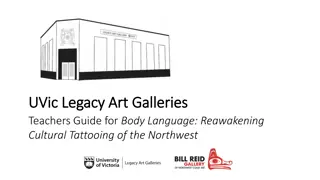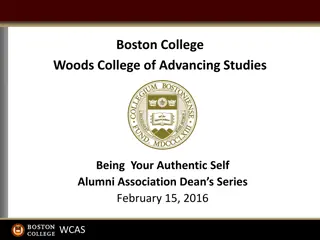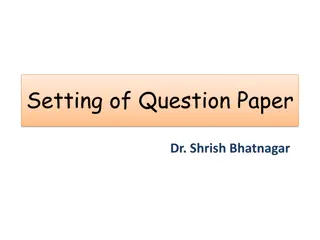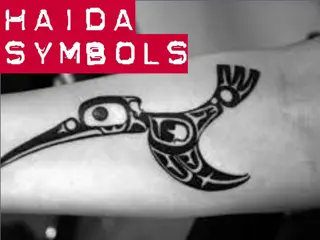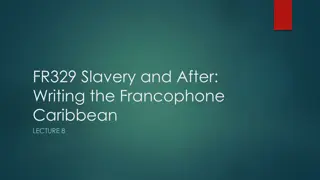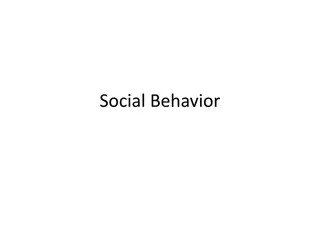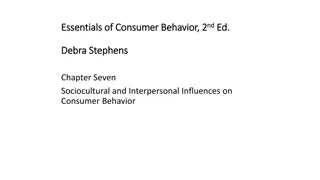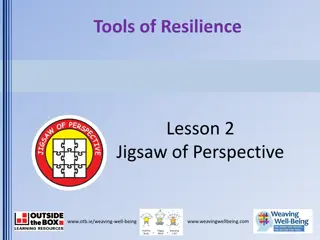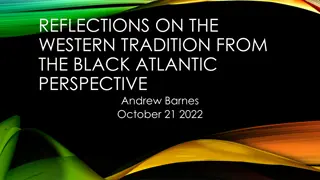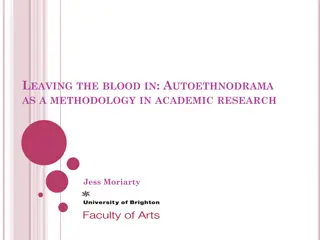Exploring Authenticity through Tattooing: A Sociocultural Perspective
Delve into the intricate relationship between authenticity and tattooing as a means of self-representation. This discourse examines how individuals navigate their sense of self amid societal expectations, with tattoos serving as visible expressions of personal identity and authenticity. Through insightful perspectives from academia and real-life experiences, the narrative sheds light on the profound connection between body art, self-expression, and social recognition.
Uploaded on Sep 28, 2024 | 0 Views
Download Presentation

Please find below an Image/Link to download the presentation.
The content on the website is provided AS IS for your information and personal use only. It may not be sold, licensed, or shared on other websites without obtaining consent from the author. Download presentation by click this link. If you encounter any issues during the download, it is possible that the publisher has removed the file from their server.
E N D
Presentation Transcript
Talking with the Body: Tattooing and representing the authentic self Dr Michael Rees University of Wolverhampton
Sincerity Authenticity congruence between avowal and actual feeling (Trilling, 1972: 4) understood to exist wholly by the laws of its own being (Trilling 1972: 124) one s outward appearance and the underlying reality of the self (Erickson 1995: 123; see also Goffman 1959)
I conceptualise of authenticity as being a combination of both an individuals own perception of themselves and the verification of authenticity by other actors within their social groupings. Thus, authenticity operates simultaneously as an individual, and social, concept and the determining factor of authenticity is recognition, by others, of being true to one s internally felt emotions, thoughts and morals.
actual gang members, real gang members. I mean, El Salvadorian gang dues with amazing tattoos and one of which had literally gotten out of prison the day before...authenticity you know (Lazlow Jones, quoted in Reilly 2013, my emphasis)
Identity and Authenticity [identity] has to be accomplished amid a puzzling diversity of options and possibilities (Giddens 1991: 3). This takes place with the cultural toolkit available to individuals (Best 2011). tattoos can be understood as processes of becoming since tattoos are part of the body s past and future at the same time (Nyman 2017: 83, original emphasis).
When I decided to become visible tattooed, I decided to myself that I was not concerned about finding a job with tattoo's because it's something that I have wanted to be done, Idefinitely thought long and hard about this but it's more important to me to live my life how I want to and not for a corporate company (Heather, 25) I have them because they re personal like your favourite shirt, if you re comfortable with it then it doesn t matter what other people think ... I fancied a couple of spirits under the eyes portraying my outlook ... I have no regrets about it. It is mine, it s what I like (Luke)
I think there are maybe two categories of people who get tattoos. You can think of girls who get the tramp stamp, like that whole idea but then there are also like the equivalent guys who get like a cross, or a tribal and they re just kind of like silly, they re conceived of as kind of stupid or silly, and not meaningful (Daphne, 25) I sometimes feel a bit sad when people have it done for no real reason; they just want any tattoo so they ve had one done (Esther, 33)
Its nice because a tattoo isnt like hair dye or a haircut, it wont grow out (Lizzy, 19) For me it is an important part of who I am, it s definitely a strong statement that I ve made about my ideology using my body, you know, it s permanent, it s forever and it s pretty visible ... there s no other way you can do that ... It s definitely a very important part of who I am (Eileen)
I think going through the pain to have something personal for me is important, it s kind of like it s almost as if it s going through a little barrier in a way. Someone wouldn t normally go out to seek pain for example if you wanted to not have the pain you d just get henna or those wash on wash off things (Siobhan, 20) It s a couple of hour s discomfort; a couple of weeks of healing and then you ve got it for the rest of your life (Damian, 41)
I really do not agree with them being heavily tattooed because most of these teenagers will regret it as most people change a hell of a lot from being 16 to 21. And this is a much harder trend to get rid of than a clothing trend. Unfortunately it is very cool to have tattoos so at a young age you want to be seen as cool and in that trend (Heather, 25) I m in a band and we played a festival in Nottingham called Hit the Deck and I ve never seen so many kids with tattoos. It made me wish I wasn t tattooed to be different. There were kids who looked like they d just turned 18 with their throats and hands tattooed (Jeff, 24) So many young people have such a lot of work done It s a statement, a way of decorating yourself but I think a lot of people do it because they think it s cool (Kate, 28)
My step mums a bit of a chav so shes got a slag tag! One of the Celtic weird little designs, one of the flash designs (Siobhan, 20) My step sister has tattoos; she s got lovely little fashionable ones as I call them I personally think they re tacky (Hannah, 27) A lot of people are going in and getting flowers or stars on the elbow for no reason, just for the fact that it s fashionable (Steve, 38)
Tattooed individuals made distinctions between those for whom tattooing was adopted as part of a genuine quests for authenticity, and those who s interest in the practice was viewed as not serious or committed enough and had been drawn to the practice because of its increasing assimilation into consumer culture which promoted the practice as fashionable.
Theres people who like to have tattoos and then theres people who like to be tattooed (Jill, 29) There are tattooed people, it s very different people who are more involved in the culture of tattoos (Jane, 22) Tattooed people know more about tattoos than people with a few tattoos (Chuck, 24)
Conclusions The construction of self-identity is an ever increasing concern for members of contemporary society and the body has become an increasingly central resource upon which authentic identities are constructed (Giddens 1991; Turner 2008; Shilling 2012). Authenticity itself is a contested concept however, one is not simply authentic or not, with what is considered authentic or inauthentic constructed within social groups in which individuals are enmeshed. Thus, members of tattoo figurations construct their authenticity vis- -vis both non-tattooed and tattooed others.
References/Bibliography ATKINSON, M. (2003) Tattooed: The Sociogenesis of Body Art. Toronto: University of Toronto Press Incorporated ATKINSON, M. (2003b) The Civilizing of Resistance: Straightedge Tattooing. Deviant Behaviour 24 pp.197- 220 BEST, A. (2011) Youth Identity Formation: Contemporary Identity Work. Sociology Compass 5 (10) pp.908- 922 ELIAS, N. (2006) The Court Society. Dublin: University College Dublin Press ERICKSON, R. (1995) The Importance of Authenticity For Self And Society. Symbolic Interaction 18 (2) pp.121-144 FOX, K. (1987) Real Punks and Pretenders the Social Organization of a Counterculture. Journal Of Contemporary Ethnography 16 (3) pp.344-370 GERGEN, K. (1991) The Saturated Self: Dilemmas of Identity in Contemporary Life. New York: Basic Books GIDDENS, A. (1991) Modernity and Self Identity. Cambridge: Polity Press GLASS, P. (2012) Doing Scene: Identity, Space and the Interactional Accomplishment of Youth Culture in Journal of Contemporary Ethnography. 41 (6) pp.695-716 GOFFMAN, E. (1959) The Presentation of Self in Everyday Life. New York: Double-day
LINDHOLM, C. (2008) Culture and Authenticity. Oxford: Wiley-Blackwell MULLANEY, J. (2012) All in Time Age and the Temporality of Authenticity in the Straight-Edge Music Scene. Journal of Contemporary Ethnography 41 (6) pp.611-635 NYMAN, N. (2017) Tattoos: An Embodiment of Desire in E. Rees (ed.) Talking Bodies: Interdisciplinary Perspectives on Embodiment, Gender and Identity. London: Palgrave MacMillan REES, M (2016) From Outsider to Established: Explaining the Current Popularity and Acceptability of Tattooing. Historical Social Research 41 (3) pp.157-174 REILLY, L. (2013) Real Gang Members Feature as Voice Actors in GTA V. IGN. Available at: http://uk.ign.com/articles/2013/09/04/real-gang-members-feature-as-voice-actors-in-gta-v [Accessed 4 September 2013) SHAKESPEARE, W. (1992) Hamlet. London: W. W. Norton & Co SWEETMAN, P. (2000) Anchoring the (Postmodern) Self? Body Modification, Fashion and Identity in M. FEATHERSTONE (ed) Body Modification. London: Sage 2000 pp.51-76 TRILLING, L. (1972) Sincerity and Authenticity. Harvard: University Press TSEELON, E. (1992) Is the presented self sincere? Goffman, impression management and the postmodern self . Theory, Culture and Society 9 pp.115-28 TURNER, B. (2000) The Possibility of Primitiveness: Towards a Sociology of Body Marks in Cool Societies in M. FEATHERSTONE (ed.) Body Modification. London: Sage. 2000 pp.39-50



